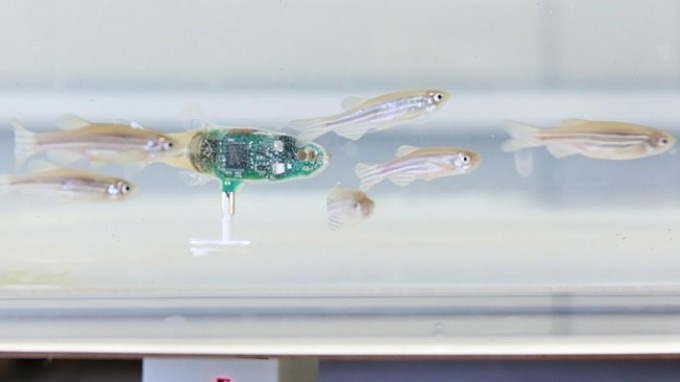Nov 9 2017
EPFL Researchers have developed a new miniature robot that can swim with fish, learn how they interact with one another, and make them come together or change direction. These unique capabilities have been demonstrated on schools of zebrafish.
 Credit: EPFL
Credit: EPFL
At EPFL’s Robotic Systems Laboratory (LSRO), headed by Professor Francesco Mondada, Researchers have created a miniature robot that can perfectly integrate into schools of zebrafish. The results of the study, conducted as part of an EU research program among six partner institutions,* were recently reported in Bioinspiration & Biomimetics.
We created a kind of ‘secret agent’ that can infiltrate these schools of small fish.
Frank Bonnet, Post-doc Researcher, The LSRO
Bonnet is one of the study’s authors and a post-doc researcher at the LSRO. Measuring seven centimeters in length, the robot is longer than the fish it is modeled after but has the same proportions and shape. Magnets fitted in the robot connect it to a small engine placed under the aquarium to push it through the water. For their study, the Researchers selected Zebrafish, or Danio rerio, as it is a robust species whose schools move about very rapidly and change direction.
The research program has two aspects. The first aspect deals with biology, exploring the social communications between individual fish. The robot allows the Researchers to create targeted stimuli and test the response of the fish. The second aspect of the program deals with robotics, and this is where the EPFL team focused its study.
Finding the right criteria
The EPFL Researchers first established the main criteria that would enable the robot to easily integrate into schools of zebrafish and then control their behavior. These criteria included the physical characteristics of the fish, like color, shape, stripes, and so on. The behavioral characteristics of the fish were also considered, such as acceleration speed, linear velocity, the size of the schools, the distance between individual fish, the rhythm at which they swing their tails, and their motion and vibrations.
The team also wanted to create a closed-loop system, which will allow the robot to affect the fish’s behavior and at the same time adapt its own behavior as well by learning how to interact and move like they do. Consequently, the swimming mechanism of the robot – originally developed with the help of Biologists – slowly enhanced as the robot spent more and more time with the fish.
Follow me!
The Researchers tested their robot in various aquariums, some of which had defined areas like little corridors and rooms. In the tests, 10 schools of 4 zebrafish each communicated with the robot and for each test, the team recorded the movement and position of individual fish; the propensity of the robot to integrate into the school; and the movement of the school of fish as a whole. The Researchers then compared these results against the observations made on schools of five zebrafish that were swimming under the same conditions – but without the robot. Their findings were indisputable.
The fish accepted the robot into their schools without any problem. And the robot was also able to mimic the fish’s behavior, prompting them to change direction or swim from one room to another.
Frank Bonnet, Post-doc Researcher, The LSRO
At the LSRO, similar tests had already been performed on cockroaches. “Fish are much more complicated animals. To integrate into an insect community, a robot simply has to emit certain kinds of pheromones. But integrating into a community of vertebrates seems to involve many more criteria, in terms of such things as appearance, movement and vibration,” says Bonnet.
*Université Paris Diderot– LIED, University of Graz – Artificial Life Lab, Cybertronica research, University of Zagreb – LARICS, FCiências.ID – Associação para a Investigação e Desenvolvimento de Ciências, EPFL - LSRO.
A robotic spy among the fish